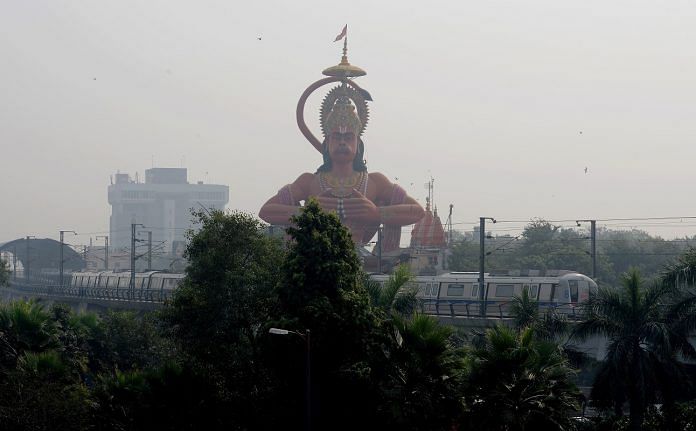Even parts of green zones like Delhi Ridge and lakes in Bengaluru are illegally occupied; Delhi HC suggested airlifting 108-ft Hanuman statue to clear encroachments in Karol Bagh.
New Delhi: There is no class divide when it comes to encroachments. From upscale residential colonies to slums to environmentally-sensitive zones, one could find squatters gobbling up land meant for public use across India.
Big cities such as Mumbai, Delhi, Kolkata and Bengaluru have fallen prey to illegal occupation of public land. A 2016 report by the Central Road Research Institute (CRRI) cited roadside parking and encroachments as the primary cause of congestion and severe traffic problems on Delhi’s internal roads.
Whether it is the slums around the Mumbai airport or the construction of structures in the protected Ridge area of Delhi, the problem exists across the spectrum. The rampant unauthorised stalls in Kolkata and the encroachment of lakes in Bengaluru are prime examples of how public spaces are being misused.
The menace is also posing a threat to environment, as in the case with the Delhi Ridge and the Bengaluru lakes.
Vijay Kumar Gautam, director (enforcement), New Delhi Municipal Council, said that religious structures are a dicey matter, but the law comes first. He was referring to the Delhi High Court’s recommendation to airlift the 108 ft Hanuman statue. Even civic agencies in Mumbai have prepared a plan to relocate such structures.
The Allahabad High Court in 2016 had made it clear that encroachment of public space can’t be allowed. “There is no fundamental or legal right to encroach upon a public road (including highway), street etc., and raise construction of any kind thereon… cause hindrance and interruption in free flow and movement of foot walkers,” the court had said in response to a petition filed by the residents of Dauda Kheda in UP regarding religious structures encroaching on their land.
“Every citizen has a fundamental right of movement and this cannot be allowed to be infringed by a few violators in public and apathy of state authorities,” it added.
Despite Supreme Court directives, local authorities have not been able to root out the problem all these years. The common trend is: many of the evicted reappear on the same or nearby spots after some time.
For instance, while there have been anti-encroachment drives on M.G. Road and in parts of Old Delhi (as recent as September 2017), the rest of the national capital continues to face the problem in some form or the other. The Rani Jhansi Flyover project missed multiple deadlines because of land encroachment issues. There has been a 10-year delay in the project leading to a three-time cost escalation.
Gautam claims that a crackdown has been launched against squatters and unauthorised vendors.
“Following an NGT order, we have cleared encroachments in Sarojini Nagar. Unauthorised vendors were removed as part of the clean-up drives. Illegal parking is also targeted,” he said.
“In Connaught Place, challans amounting to Rs 1 lakh were issued for violations. Temples and mosques (mazaars) that came up on public land were removed as well. Even in posh areas like R.K. Puram, illegally parked cars were impounded,” Gautam added.
He asserted that encroachments kept increasing despite steps taken by the NDMC. “The creation of Laxmibai Nagar Market after Connaught Place become a non-vending zone really helped reduce encroachments in that area,” said Gautam.
Anil Wankhede of the Mumbai Metropolitan Region Development Authority said religious structures are always difficult ones to handle. “Removing structures glorified by locals can cause grievances. The recent high court judgment has laid down guidelines, according to which, no structures built after 1997 causing problems to pedestrians or road congestion are entitled to regularisation,” he added.
Local corporations have been instructed to make a list of structures that need to be relocated, Wankhede said.
He informed that around seven-eight such structures have been relocated in Mumbai. “We removed and reconstructed them in more viable spaces,” he said.



